15 Best Systems Management Tools for 2023 (Paid & Free)

Centralizing the management of IT assets makes it easier to stay productive. Maintaining your infrastructure helps to mitigate security and performance concerns so that your employees can work freely without being held back by downtime or sluggish performance.
To manage and monitor lots of systems effectively you need a systems management tool. Systems management software and tools enable network administrators to manage infrastructure and applications from one location.
Mục lục bài viết
Here is our list of the best systems management tools and software:
Our methodology for selecting systems management tools for this list
We reviewed the market for systems management solutions and assessed the options based on the following criteria:
- A discovery service to generate an asset inventory
- Automated maintenance task performance
- Software license management
- Remote access tools
- Technician activity logging
- A free trial or a demo system that provides a free assessment period
- Value for money from a system that improves technician efficiency
Taking this list of requirements into consideration, we found a group of systems management packages that include both on-premises and SaaS packages.
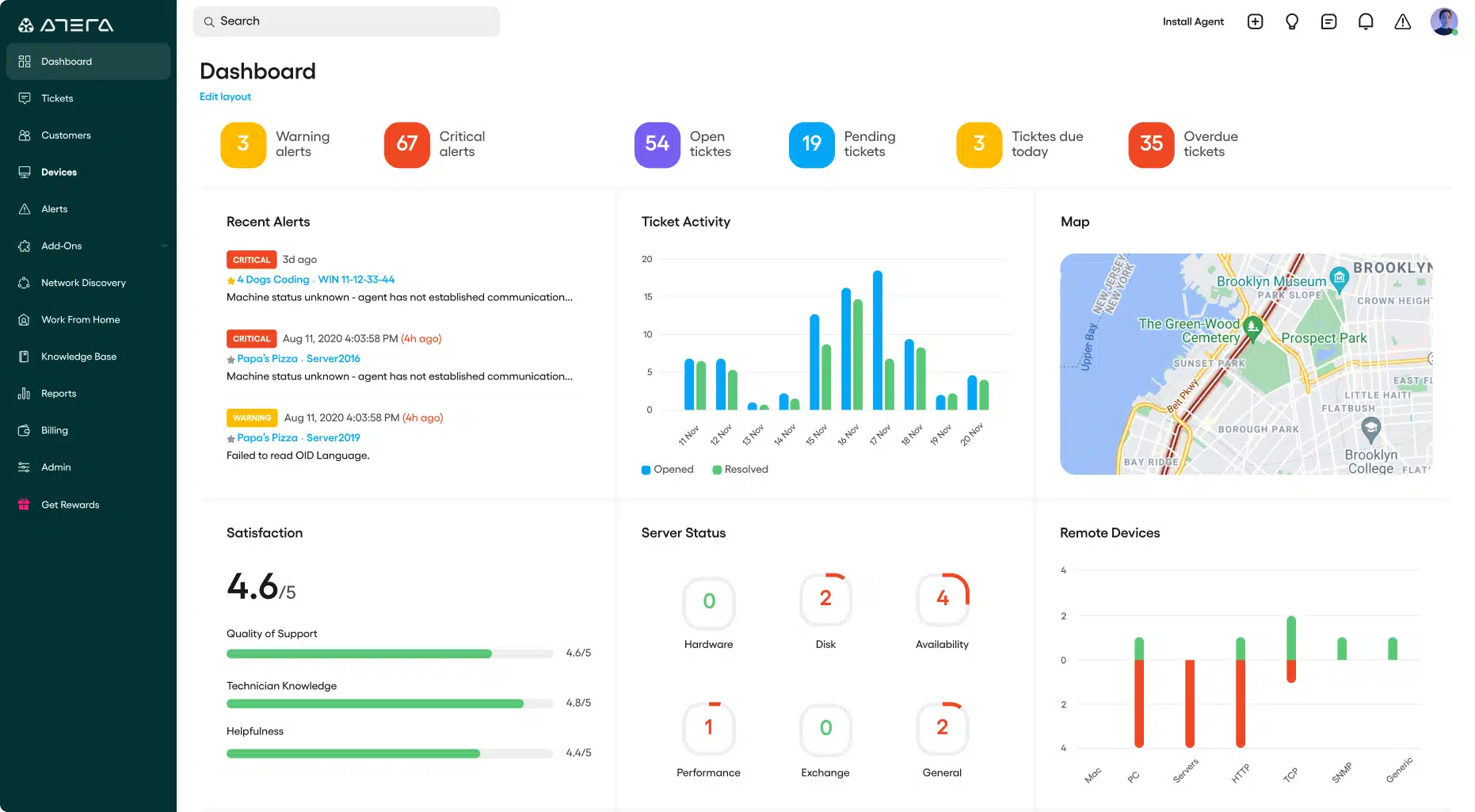
Atera is a bundle of software for managed service providers that includes professional service automation (PSA) and remote monitoring and management (RMM) systems. This is a multi-tenanted service.
Key features:
- Remote access
- Patch management
- Monitoring alerts
- Self-help customer portal
- Ticketing system
The package is able to manage endpoints running Windows, Windows Server, and macOS. When a system is enrolled in the monitoring service, an agent needs to be downloaded onto each monitored device. This facilitates remote access and it also gathers software information. This creates a software inventory.
The patch manager refers to the OS and software versions registered in its inventory and regularly checks with the providers of those packages for updates. When one is available, the Atera system copies over and saves the installer. This will be installed during the next available maintenance window.
As well as offering these system management features, Atera includes automated monitoring services. These are based around a system of thresholds placed on each of the performance and resource utilization metrics that it tracks. When one of those levels is crossed, the Atera system raises an alert.
Atera’s PSA functions add on client and contract management features that also include automated timesheet generation for billing. As well as offering these system management features, Atera includes automated monitoring services. These are based around a system of thresholds placed on each of the performance and resource utilization metrics that it tracks. When one of those levels is crossed, the Atera system raises an alert.
Pros:
- Device discovery
- Software inventory scanning
- Remote access
- Automated system maintenance processes
- Scheduled and on-demand patch management
- Knowledge base framework
- Technician team management
Cons:
- No agent for Linux
Atera is a subscription service with three plans. The system can be paid for monthly or yearly with a lower monthly rate for the annual subscription. You can assess Atera with a free trial.
EDITOR’S CHOICE
Atera is our top choice for a system management tool because it offers comprehensive packages of remote management tools that are suitable for use by managed service providers and in-house IT support teams. Managed service providers can even get tools to run their own teams, which means that all of the services needed to run a remote system are delivered from the cloud, so you don’t need to host that software on your own servers. You get automated monitoring tools and also task automation tools, such as software deployment systems and an automated patch manager included in these packages. Choose the level of service that is appropriate to your business’s system management needs.
Download: Access the Free Trial
Official Site: https://www.atera.com/signup/
OS: Cloud-based
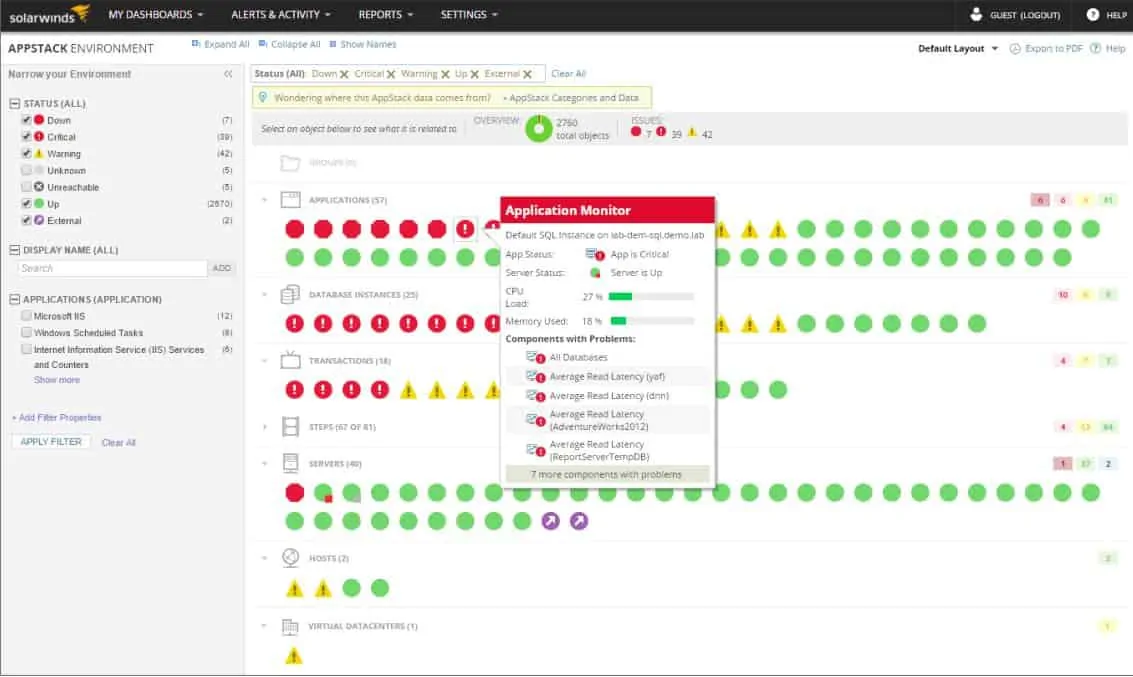
SolarWinds Systems Management Bundle is a system monitoring bundle that includes four different tools: SolarWinds Server & Application Monitor, SolarWinds Virtualization Manager, SolarWinds Storage Resource Monitor, and SolarWinds Web Performance Monitor. These tools automatically discover infrastructure and applications throughout your network.
Key Features
- Covers servers and services
- Includes virtualization monitoring
- Stack drill-down
- Web server monitoring
- System administration tools
Performance can be monitored through the PerfStack dashboard. The dashboard displays performance data as graphs and charts. There are also over 1,200 infrastructure monitoring templates to help you get up and running ASAP.
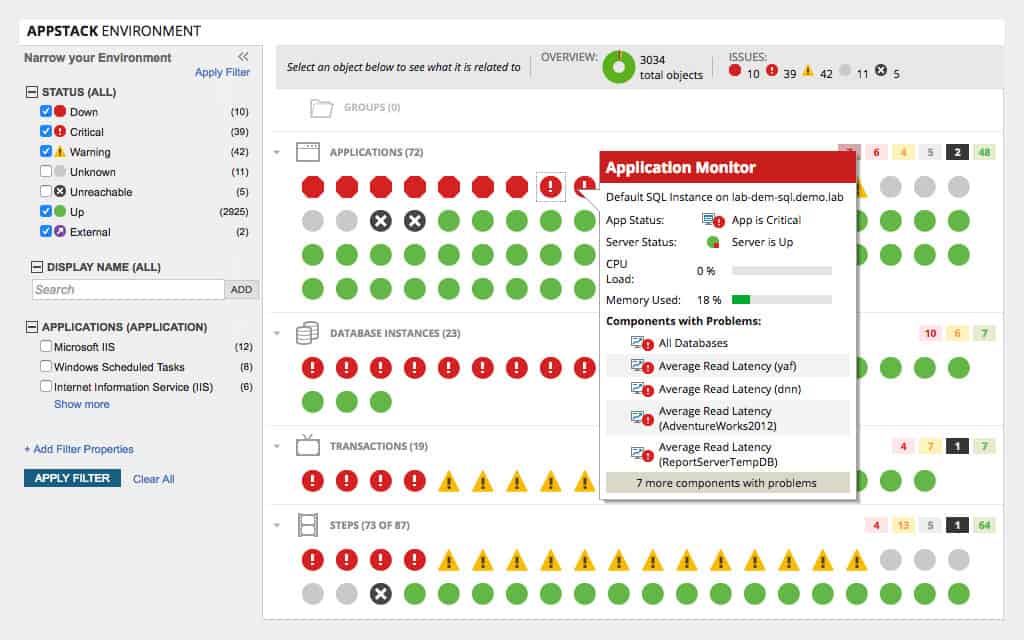
Overall, we particularly like the AppStack dashboard view that helps network admins visualize application instances, server instances, transactions, hosts, virtual datacenters, and more all in the one view.
Pros:
- Includes a full suite that covers application, network, and infrastructure monitoring
- Over 1200 templates help new users start seeing insights quickly
- Customizable widgets allow users to create their own dashboards and reports easily
- Alerting can be configured to notify based on SMS, email, or third-party app integration
Cons:
- SolarWinds Systems Management Bundle is designed for IT professionals and isn’t made for non-technical users
You can pick and choose which products you want to use in the bundle. SolarWinds Server & Application Monitor is the server monitoring solution and costs $2,995 (£2,316). SolarWinds Virtualisation Manager is the virtualization management component that costs $2,995 (£2,316).
SolarWinds Storage Resource Monitor is a storage management platform that starts at $2,995 (£2,316). SolarWinds Web Performance Monitor is a website monitoring tool that starts at $1,995 (£1,543). You can start a 30-day free trial.
SolarWinds Storage Resource Monitor
Start 30-day FREE Trial

SuperOps RMM is a cloud-based service that provides all of the tools that an MSP’s technicians need to monitor and manage the systems of their clients.
Key Features
- Network and endpoint monitoring
- Device management
- Patch management
- Automated inventories
- Associated PSA
The SuperOps RMM package is a SaaS platform. It includes routines that scour an enrolled network and document all of the equipment that it discovers. This asset inventory forms the basis of continuous system monitoring. The autodiscovery process repeats periodically, keeping the asset inventory up to date.
The monitoring service queries network devices and endpoints for statuses. It also monitors resource usage. The monitor is driven by thresholds and if one of those gets crossed, an alert gets raised. The notification feature in SuperOps enables automated, unattended system monitoring. Technicians only need to get involved when a problem arises.
Other features in this systems management package include a Patch Management service. This works off a software inventory that is compiled by the asset discovery system. The patch manager constantly polls the sites of software providers for updates. When a patch becomes available, the SuperOps Patch Management system copies over the installer, queues the patch up, and applies it at the next available maintenance window.
Pros:
- Automatic asset discovery
- Documents entire systems
- Includes an automated patch manager
- Has an alerting system that enables unattended monitoring
- Logs all management activities
- Provides remote monitoring and management tools for remote systems
Cons:
- Doesn’t monitor endpoints running Linux or macOS
The SpecOps service is offered in four plans, which are all charged for by subscription. Three of these four plans include the RMM module and all of them offer a professional services automation (PSA) package. You can experience any of the plans on a 21-day free trial.
SuperOps RMM
Start 21-day FREE Trial
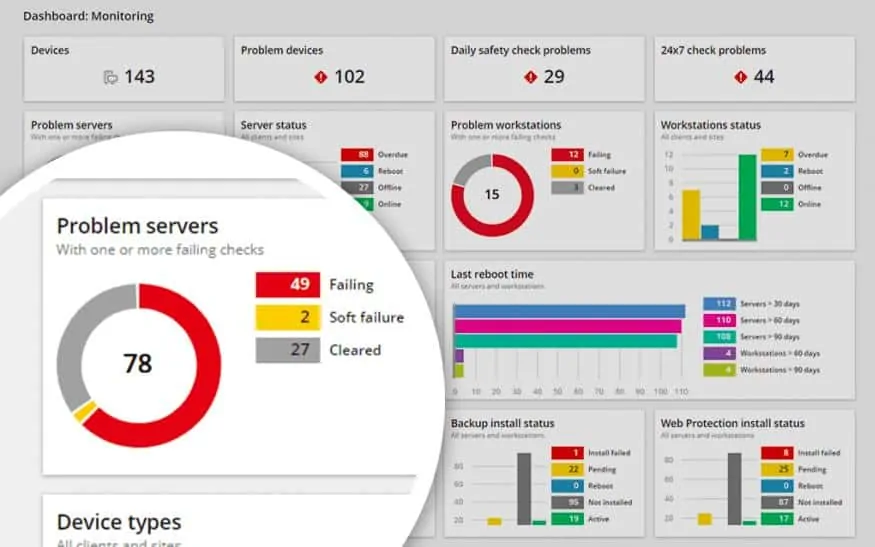
N-able N-sight is a SaaS remote monitoring and management software package that supports the management of all types of IT resources.
Key Features
- For IT departments or MSPs
- System monitoring
- IT asset management
- Sensitive data management
- Task automation
The system monitors networks, servers, endpoints, mobile devices, and applications and it includes extensive systems management facilities. The systems management functions in the software service include task automation for regular maintenance jobs and for problem resolution and incident response. The system also includes a network discovery feature that takes care of inventory documentation and it is able to track down PII and track access to it for data security standards requirements.
Being a SaaS system, this service includes all of the supporting resources needed to run the RMM. This means that the company using this RMM doesn’t need to provide server space for file storage or processing power to run the monitoring and management software.
The dashboard for the service is hosted on N-able servers and it can be accessed through any standard web browser or a special mobile app. The systems being monitored and managed can be located anywhere, as long as they are connected to the internet. The management functions also give controls over cloud-based resources.
Pros:
- Excellent monitoring dashboard, great for MSPs or any size NOC teams
- Scalable cloud-based deployment
- Monitor for anywhere via web browser
- Automatic asset discovery makes inventory management easy, even on busy networks
- Wide range of automated remote administration options make it a solid choice for helpdesk support
Cons:
- The platform can take time to fully explore all of its features and configuration options
There are no setup fees for N-able N-sight and the service is charged for by subscription with no deposit required. N-able N-sight removes all of the upfront costs that other system management tools usually require. N-able N-sight is available for a 30-day free trial.
N-able N-sight
Start 30-day FREE Trial

NinjaOne – formerly NinjaRMM – is a cloud-based platform that provides all the monitoring and system management tools that an IT department needs to support multiple sites. The service allows multi-tenant accounts, so it can be used by managed service providers (MSPs) to manage the IT systems of several clients simultaneously.
Key Features
- Automatic network discovery
- Asset inventory
- Task automation
The service includes an initial system scan to discover all of a network and log all devices connected to it. This creates a hardware and software inventory, which is the basis of all system management utilities in the NinjaRMM package.
Device management facilities in the NinjaOne platform include an onboarding system that allows standard configurations and software profiles to be stored. This can automatically set up devices in bulk or individually. Other management systems for endpoints are patch and update management and software license management.
If new devices are added to the network or a device is removed, the NinjaOne automatically detects the change, updates the asset inventory, and alerts an operator. NinjaOne provides constant automated monitoring of all system events and network activity.
Pros:
- Free trial
- Supports over 120 integrations making it a solid option for already established organizations
- The interface can be customized to both monitor clients as well as manage device inventory
- Builtin remote access with remote commands allow technicians to troubleshoot without initiating a session
- Supports custom scripts that can be deployed to multiple clients
Cons:
- Would prefer more reporting options
- The device list could use better filters and search features
The NinjaOne system is charged for by subscription with a rate per monitored device. The console for the platform is accessed through any standard browser. You can access a 30-day free trial of NinjaOne to check it out for yourself. You can also request a free detailed quote for your circumstances.
NinjaOne
Start 30-day FREE Trial
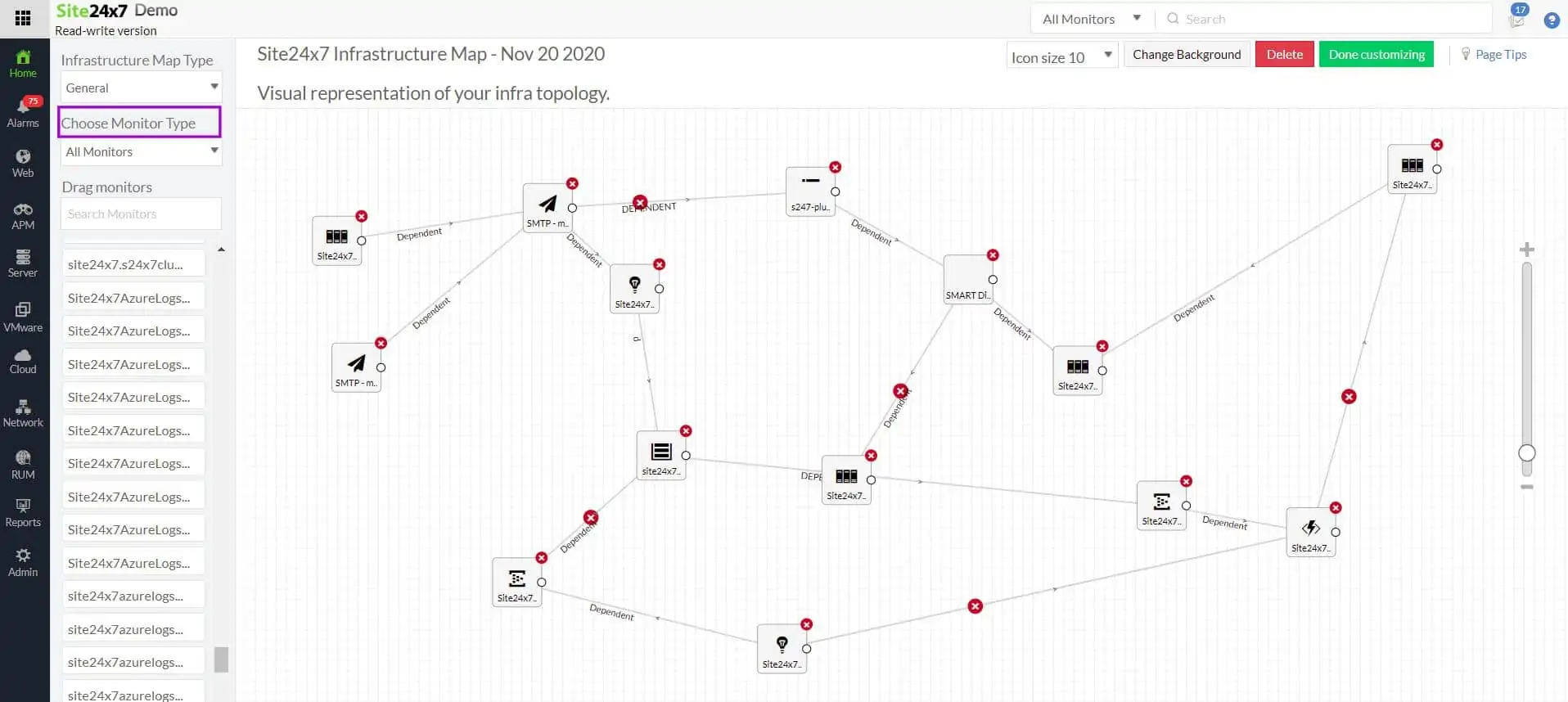
Site24x7 is a cloud-based platform of monitoring tools. The platform includes a large number of individual monitoring tools and they are bundled into packages. These packages are:
- Website Monitoring
- Site24x7 Infrastructure
- Application Performance Monitor
- All-in-one
- MSP
The theme of each package is evident from its name. However, there is a great deal of overlap in the contents of the plans. For example, the website monitoring features in the Website Monitoring plan are also included in all other plans. The Application Performance Monitor and the Infrastructure plan have very similar modules.
Key Features
- Network, server, application, and website monitoring
- Virtualization monitoring
- Status alerts
All of the plans include server monitoring and network monitoring features, so all can be said to contribute toward system management.
Another element of all plans is the Site24x7 Log Management module. This collects Windows Events and Syslog messages as well as the log messages that many application s put out. The Log Manager collects log messages, converts them into a common format, and stores them in files. The system also includes a data viewer that includes features to sort, filter, and group records for analysis.
Pros:
- Cloud-based service minimizes startup costs for new MSPs
- Supports multiple alert channels including push notifications to Android and iPhone
- Monthly plans are designed to fit small new businesses as well as established enterprises
- Excellent root cause analysis for faster ticket resolution
Cons:
- Would like to see a longer trial period for testing
Site24x7 offers each of its tools on a 30-day free trial.
Site24x7
Start 30-day FREE Trial
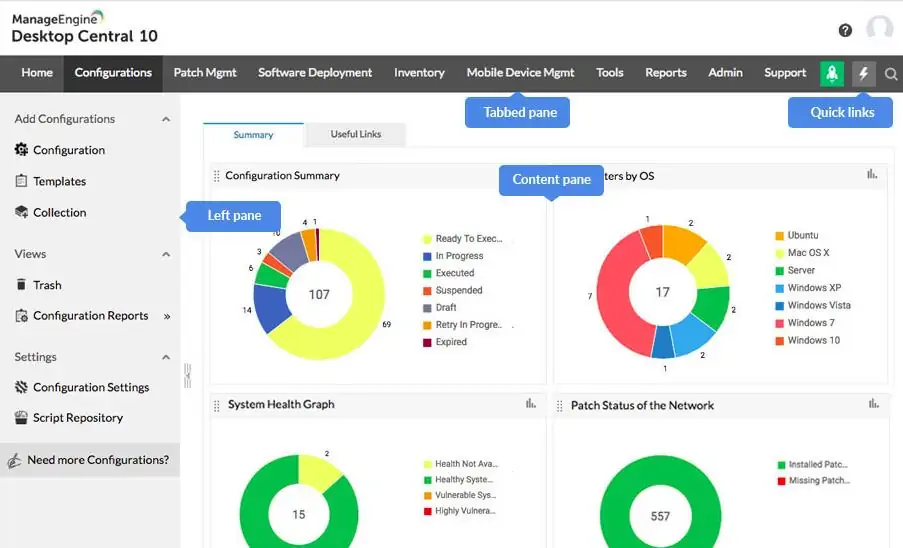
ManageEngine Endpoint Central is a fleet management service for endpoints. This is a bundle of tools that includes all of the systems that you will need in order to manage the endpoints in your company’s inventory. The service is available in four editions and all of them include functions for system management, such as device discovery, patch management, software inventory tracking, and configuration management.
Key Features
- Endpoint monitoring
- Patch management
- Configuration management
The Endpoint Central system is able to manage devices running Windows, macOS, Chrome OS, and Linux. The highest plan also includes a Mobile Device Management module that supports devices running iOS, Android, and tvOS. This service is available to the other paid plans as an add-on. All plans also have a security monitoring add-on option.
Pros:
- Available on-premise or as a SaaS offering
- Can be installed on both Windows and Linux platforms, making it more flexible than other on-premise options
- Offers in-depth reporting, ideal for enterprise management or MSPs
Cons:
- ManageEngine provides a suite of monitoring tools that can take time to fully learn and understand
ManageEngine offers Endpoint Central in four editions. The lowest of these is Free and it is suitable for small businesses that have up to 25 devices. The three paid versions are Professional, Enterprise, and UEM. The Professional plan gets you desktop and laptop management functions and starts at $795 per year to manage 50 devices with access for a single technician. The Enterprise edition starts at $945 per year to manage 50 devices and it adds on software management and a self-service portal for users. The UEM edition adds on mobile device management and OS deployment features for a starting price of $1,095 per year to manage 50 devices.
You can get the software for Endpoint Central to install it on Windows Server or use the cloud-based SaaS version of the system. Both deployment options are available for a 30-day free trial.
ManageEngine Endpoint Central
Download 30-day FREE Trial

Paessler PRTG Network Monitor is a network monitoring tool that can monitor infrastructure, traffic, and applications. PRTG Network Monitor automatically discovers devices by pinging IP ranges. Through the dashboard, you can monitor your network with real-time visualizations, including dials, maps, and charts.
Key Features
- System monitoring
- Network discovery
- Status alerts
The server monitoring capabilities of PRTG Network Monitor are particularly diverse. The product can monitor mail servers, web servers, database servers, and file servers. There are unique sensors for databases like MySQL, Microsoft SQL, and Oracle SQL.
To keep you updated on security events, PRTG Network Monitor has an alerts system with an API for creating custom alerts. Whenever the system detects problematic activity it sends an alert through email, SMS, or push notification. Push notifications are available for users who download the free Android or iOS apps.
Pros:
- Customizable sensors for virtually any application, server, or service
- Integrates well into the PRTG ecosystem
- Flexible pricing based on the number of sensors in use make it applicable for small and large-scale networks
- Live network maps enable technicians to visualize complex network infrastructure
- Dozens of integrations into other ticketing systems and messaging applications
Cons:
- Designed for IP professionals, sensor setup and integrations require technical knowledge
There is a freeware version of PRTG Network Monitor for enterprises using less than 100 sensors. Then there is a range of versions that increase in price depending on the number of sensors you need to support. PRTG 500 starts at $1600 (£1,237) for 500 sensors and one server installation. You can download a 30-day free trial.
Paessler PRTG Network Monitor
Download 30-day FREE Trial
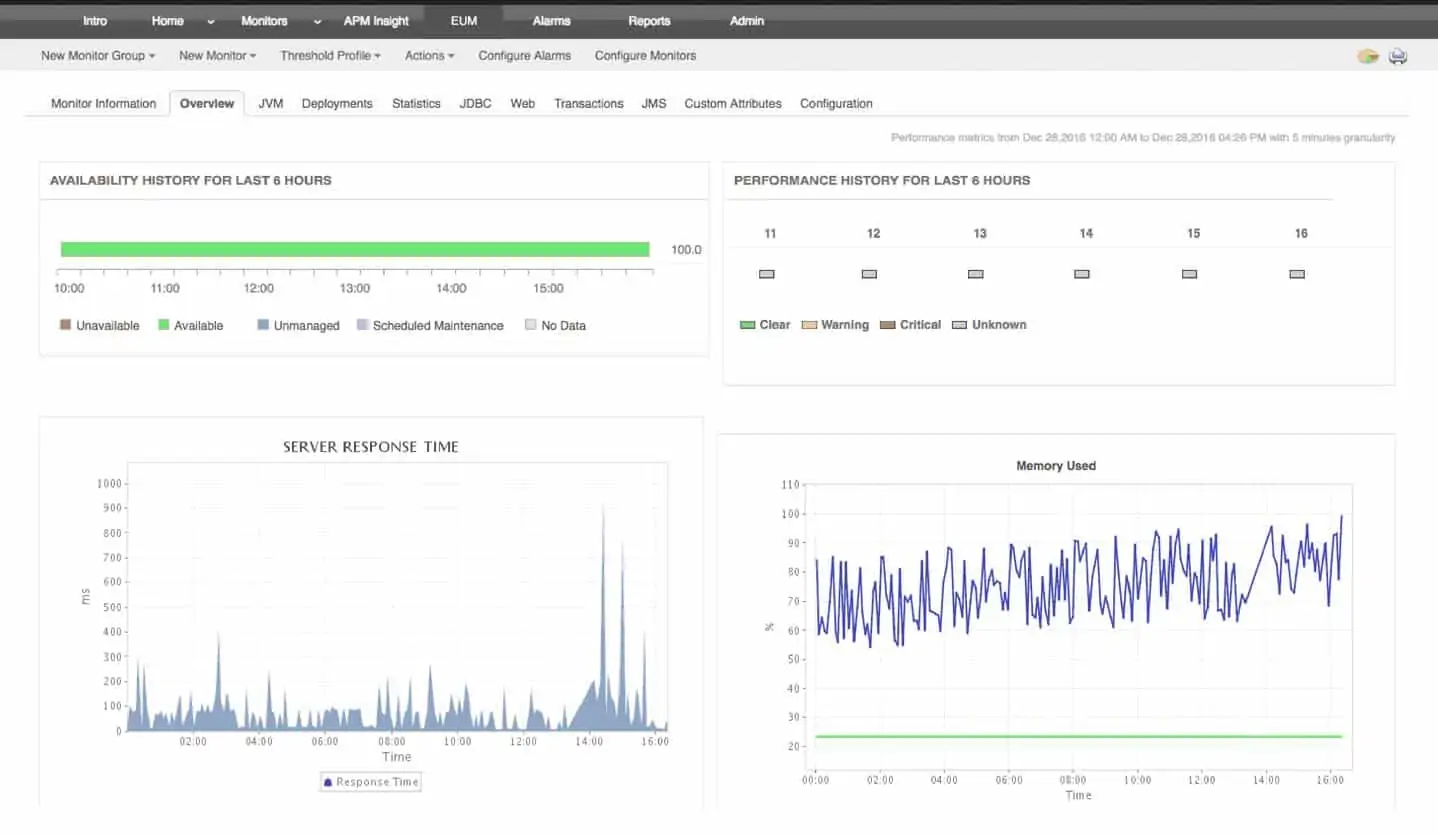
ManageEngine Applications Manager is a vital monitoring system for the modern IT infrastructure. This tool is able to track both on-premises and cloud resources and track the implementation of virtual infrastructure as well as map the applications landscape that serves an organization.
Key Features:
- Application dependency mapping
- Virtual infrastructure monitoring
- Cloud server monitoring
The applications that this system will monitor include fundamental, essential services for any business, such as databases, Web servers, and mail servers. In fact, this service can monitor 500 different applications.
Reaching out across the Internet, the Applications Manager will monitor cloud services, including virtual servers and storage facilities. The system also includes tools for testing and monitoring websites. These services include availability and response time monitoring and synthetic monitoring tools that exercise interactive elements in web pages.
ManageEngine offers the Applications Manager in three editions: Free, Professional, and Enterprise. The Enterprise plan includes very important distributed tracing functions, which are vital for businesses that use Web APIs and microservices. The Professional edition still includes plenty of useful tools, such as application dependency mapping and performance alerts.
Pros:
- Offers on-premise and cloud deployment options, giving companies more choices for install
- Can highlight interdependencies between applications to map out how performance issues can impact businesses operations
- Offers log monitoring to track metrics like memory usage, disk IO, and cache status, providing a holistic view into your database health
- Can automatically detect databases, server hardware, and devices for real-time asset management
Cons:
- Can take time to fully explore all features and options available
The Free edition of Applications Manager is limited to running five monitors. However, that isn’t the only path to getting the Applications Manager for free. ManageEngine Applications Manager is available for a 30-day free trial. If you choose not to buy the service pay the end of the trial period, your software switches over to the free version. The software installs on Windows Server and Linux.
ManageEngine Applications Manager
Download 30-day FREE Trial
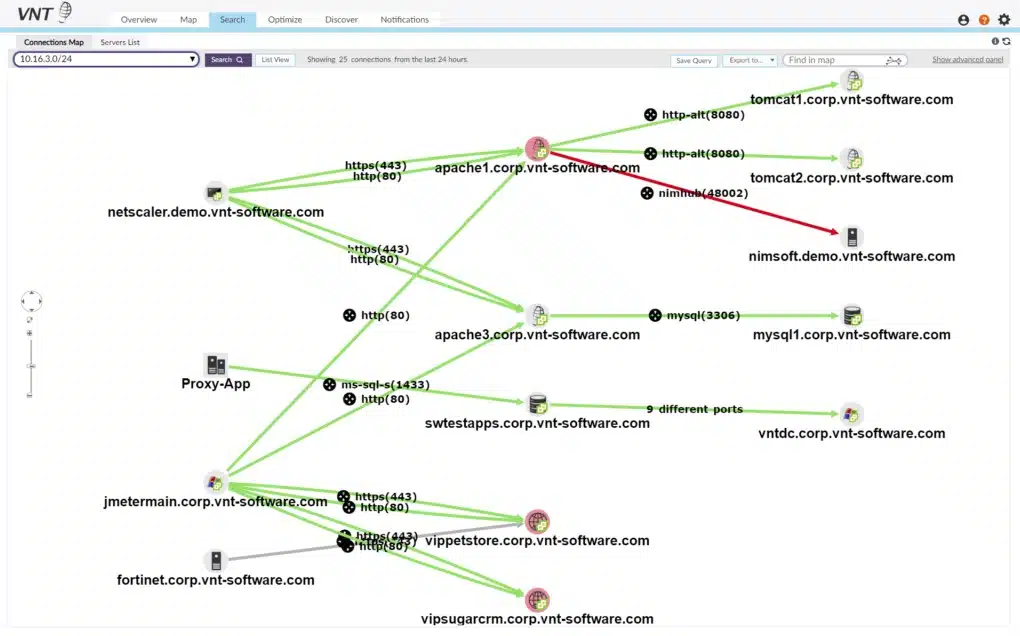
Faddom is an on-premises software package that specializes in the discovery and mapping of any collection of assets. The system is particularly useful for application dependency mapping and network topology mapping. Once the discovery process has run the first time, you are presented with a plan of your system with each node providing a click-through to a details page. The system is able to provide ongoing monitoring of network and application performance.
Key Features
- Continuous discovery and mapping
- Application dependency mapping
- Network topology mapping
The discovery process repeats continuously, so the device inventory and maps get updated if any changes occur in the environment. The tool also provides a software inventory, which can be used for license management and patch management.
The application dependency mapping service provides a basis for activity monitoring for all layers of supporting services. It also enables you to implement Web application security.
Pros:
- Automated discovery and mapping
- Constant environment mapping updates
- Application dependency discovering and monitoring
- Network device health monitoring and bandwidth analysis
Cons:
- No cloud-based version
There are two editions for Faddom. The price for the package increases with the number of nodes that you want to track. The installation package for Faddom includes its own VM, so the service will run on any operating system. You can try out the Faddom system with a free trial.

Nagios XI is an infrastructure management tool that provides a top-down perspective of network performance. Customizable dashboards give you complete control over how your network is monitored. There is a range of displays, including graphs and maps you can use to monitor network performance.
Key Features
- Performance monitoring
- Capacity planning
- Management task automation
Features like automated capacity planning graphs keep you aware of the status of your current systems. Scheduling capacity planning reports help you to make sure that your usage requirements don’t exhaust your resources and put you out of action.
The extensibility of Nagios XI makes it a top-notch product. There are APIs for integrating with external applications and a range of add-ons developed by the community on the Nagios Exchange. The plugins on Nagios Exchange allow you to further customize your monitoring experience.
Pros:
- Open-source transparent tool
- Simple, yet informative interface
- Flexible alerting options support SMS and email
- Robust API backend makes it a great option for developers who want to integrate their own custom applications
Cons:
- Would like to see additional integrations into more ticketing systems
- Installation can be technical and complex
There are two versions of Nagios XI available to purchase; Standard Edition and Enterprise Edition. The Standard Edition starts at $1,995 (£1,512) with features including configuration wizards and reports. The Enterprise Edition starts at $3,495 (£2,703) and includes features like capacity planning reports, audit logging, and more. You can download the free trial.

Zabbix is an open-source system monitoring solution. Zabbix blends server, cloud, application, and network monitoring into one platform. You can monitor network health, bandwidth usage, and configuration changes. The visualization capabilities are vast with everything from charts and graphs to cluster displays (logical maps of clusters).
Key Features
- Free to use
- Automated IT asset management
- Adaptable with free add-ons
Templates provide you with out-of-the-box configurations, graphs and discovery rules for a range of vendors. There are templates available for Cisco, Dell, Intel, Juniper Networks, Huawei, Netgear, Hewlett Packard Enterprise, and more. There is also a range of additional templates and modules that can be found on the community site.
Pros:
- Can track metrics such as network connectivity, power consumption, temperature, and disk metrics providing a holistic look into the health of the device
- Wide variety of alerting options, SMS, email, third party integration
Cons:
- Open-source version lacks paid support options, reliant on community for bug fixes
- Interface can feel crowded when tracking a large number of devices
- Only available for Linux machines
Zabbix is recommended for enterprises that want a low-cost tool with premium functionality. Zabbix is available for Red Hat Enterprise Linux, CentOS, Oracle, Linux, Ubuntu, Debian, SUSE Linux Enterprise Server, and Raspbian. You can download the software for free.
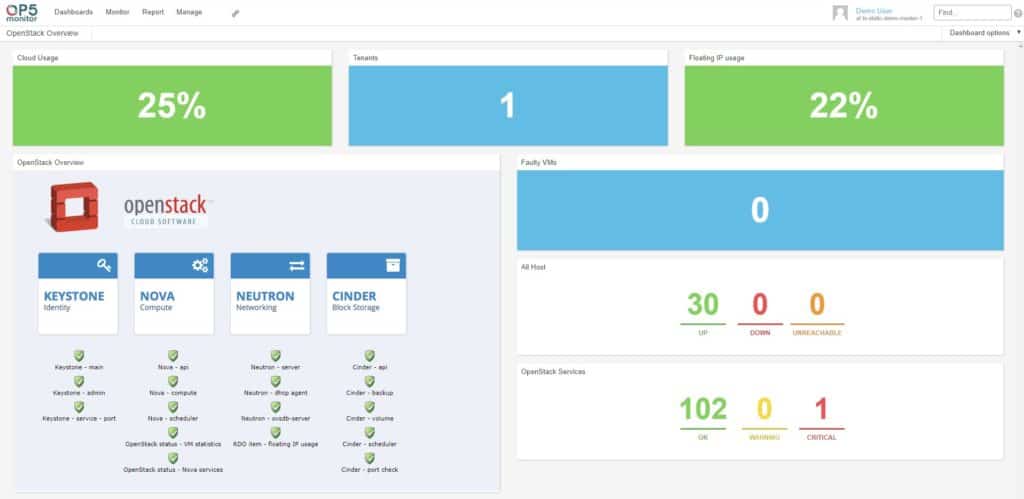
OP5 Monitor is an open-source network and SNMP monitoring tool. OP5 Monitor has an auto-discovery feature that automatically discovers devices connected to the network. Once the program discovers your SNMP-enabled devices, you can start to monitor performance and availability. There is out-of-the-box support for a range of vendors to reduce the level of configuration needed.
Key Features
- Automated asset inventory
- SLA templates
- Performance monitoring
However, you can configure your own alert rules and notifications and configure notifications for networks, databases, and OS resources. For example, if key resources are running low on disk space or CPU load is unusually high then the software will send you a notification.
Reports allow you to further analyze your network activity. There is a range of reports including alert summary, alert history reports, availability reports, SLA reports, and more. Reports can be saved as PDF or CSV files.
Pros:
- Simple dashboard, great for team environments
- Offers additional support for onboarding to help new users
- Utilizes autodiscovery to reflect accurate lists of managed assets
Cons:
- Open-source version lacks paid support options, reliant on community for bug fixes
- Pricing is only available upon request
- Would like to see more compliance-based reporting options
You can request pricing from the company directly (the price will depend on the number of devices that you are looking to support). Download the 30-day free trial.

KACE Systems Management Appliance is a systems management platform that allows you to monitor computers, laptops, servers, tablets, printers, storage, and more. The software helps you to manage resource allocation, manage your inventory of IT assets, and perform software license management.
Key Features
- IT asset inventory
- Software license management
- Vulnerability scanning
The platform doesn’t just give you more visibility but also allows you to perform tasks like vulnerability scans and patching. Checking for vulnerabilities and remotely patching devices saves you time and reduces vulnerabilities that could potentially be exploited by an attacker. There are also alerts that notify you about performance events.
Pros:
- Can manage devices as well as licensing information
- Offers built-in vulnerability scanning as well as patching
- A simple dashboard provides a clutter-free view of important metrics
Cons:
- Not suited for MSPs or larger multi-site organizations
- Must contact the sales team for pricing
KACE Systems Management Appliance will work well with enterprises that want to manage IT assets from a single location. However, you will have to contact the sales team to view the pricing information. You can download the free trial.

ConnectWise Automate is a systems management platform that combines infrastructure monitoring with automation capabilities. ConnectWise Automate automatically discovers devices so they can be monitored. There are remote control sessions so you can automatically record remote sessions to monitor user activity and comply with auditing requirements.
Key Features
- System inventory management
- Automated patching
- Performance and security monitoring
ConnectWise Automate has an alerts system so that you receive notifications about performance issues and security events. Notifications ensure that you never miss any vulnerabilities or other issues that could affect your network.
Systems patching is one of the most useful features included with ConnectWise Automate. With the patching feature, you can patch Windows devices remotely. Patching devices remotely make your IT management process more efficient.
Pros:
- Remote management, inventory management, and reporting are all accessible from a single dashboard
- Interface templates can be made for individuals or entire teams
- Very easy remote access to endpoints through multiple protocols
- Supports automation as well as remote troubleshooting without impacting the user session
- 100+ pre-configured commands and templates to use out-of-box.
Cons:
- Prefer a longer trial period to explore all features
- The interface can be confusing, especially in the reporting and management areas
- The user chat function is clunky at times
ConnectWise Automate is a platform designed for environments where administrators seek to automate network monitoring tasks and reduce manual administration. To view the price for ConnectWise Automate you will have to contact the company directly. You can download the free trial.
Choosing the right systems management tool or software can be the difference between a normal productive day at the office or going back to the dark ages! All of the tools listed in this article are suitable for system management in modern IT environments.
If you’re looking for complete systems management packages, then the SolarWinds System Management Bundle or Paessler PRTG Network Monitor are great starting points. The latter would also work well in environments that desire a freeware product. If you want to go the open-source route then Zabbix is another excellent unified monitoring solution.
Recommended reading:
What is system management tool?
System management tools support IT operations teams in looking after IT assets. The management tools should facilitate regular maintenance tasks with automated processes. Hardware monitoring and software management utilities should also be included.
Is system management a software system?
System management services are implemented as software. This can be provided as a self-host package or as part of a SaaS package run on a cloud server.
What are common tasks of IT system management?
IT systems management software needs to provide automated maintenance services, security tracking, compliance management, and IT asset management.











